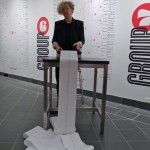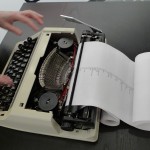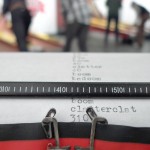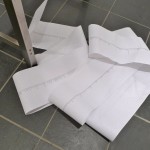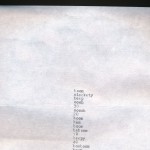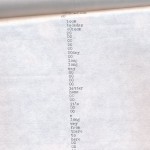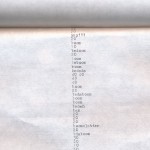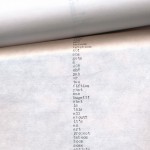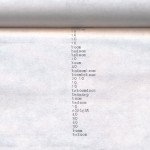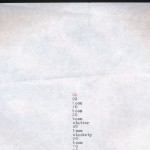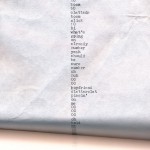At 11am on Tuesday, April 3rd, Sal Randolph posted herself at a tall table in the gallery—manual typewriter and two 25′ rolls of paper at the ready—and recorded whatever there was to see, hear, notice. For four hours. Below are picts documenting the creation of the Combat Log and a few scans of sections of the latter.
Randolph wrote up a narrative account of the process, and I wrote my own quasi-critical, interpretative account. She requested that I include them both:
Sal Randolph:
The boom and clatter of balls—a cacophony, a symphony—polyrhythmic, always varying. I watch the balls roll, bounce, fly, get caught in rings. I hear the balls thunder resonantly against the wood as they are first bowled, bang and clatter in as they jump up around the rings, rattle down through the innards of the game, coming to rest in a neat row, ready at hand. A game, from the small distance where I stand, is as much sound as sight. Its overwhelming music fills my body. I start to log, beginning with sounds, boom boom, trying to follow the rhythms of what I hear, and then scores, 10, 10, 40, 10, watching the balls find their holes. With even one game going it is impossible to keep up with both sound and score at once. I carry on with the impossible, all ears and eyes, and fingers hitting the keys. The typewriter, usually loud, hardly makes an imprint in the noise. Bang! Boom! 100! 10 10 30 boom clatter 240. Three games going, five games at once, all making an intricate pattern of sound and score. Trying to catch the rhythms, baboom badaboom clatterclat, catch as many events as I can. Sometimes voices shouting out or moments of conversation suddenly audible. And then the lulls: in between games I hear songs— playlists for winning and losing. I keep recording the scores, but now as zeros to represent the absence of play: 00 00 00 00 and words that cut through the echoing rush of the music in the reverberant space: I’ll never fall in 00 00 00 in love again 00 00 00. Soon enough, though, someone comes to play. A person practicing their 100s gets mostly 10s, and I learn each has a distinctive sound. I can hear a 100 go in even if I’m looking down at my hands on the keys. 100! I give them an exclamation point every time, for luck and triumph. Victories, defeats and disappointments, solid runs of 40s, all become part of a log that doesn’t stop for anyone, it just keeps going, capturing everything it can, a momentum.
John Muse:
Randolph’s logs capture the moment to moment activity of the gallery, not only the boom, clatter, “bahdada / boom / bahdada,” “behdeh” of the machines and players, but the scene’s various scores: the music, the voices, and the skee-ball scores. The logs are laborious, stark, starkly useless, and teaming with detail that correspond to no dramatic arc, no punchy conclusion or tenuous build-up. Sure, the occasional “100!” surfaces, but games don’t begin and end, players don’t show up to occupy center stage; the elements mix, all of a piece. Randolph gives us a smooth surface of transcription, slipping out from under constraints of description or even good-enough field recording—what could anyone do with these logs but read them? And reading them doesn’t seem to be as important as their very existence. They testify to their production and to the oblique charge of a mechanical system that, perhaps like skee-ball itself, is rich precisely because obsolete, dainty, fragile, and yet still just hard enough to play well. Randolph plays the typewriter and lets us hear the skee-ball machines playing themselves: do the onomatopoetic syllables of “badoombopbop” capture the roll and double-thunk of a ball? Maybe, but the typewriter/alphabet/skeeball system comes to the fore. The logs mimic and stage the entire machinic assemblage, one in which they participate as well.
See all posts about Sal Randolph.
See all posts about the Combat Log.

